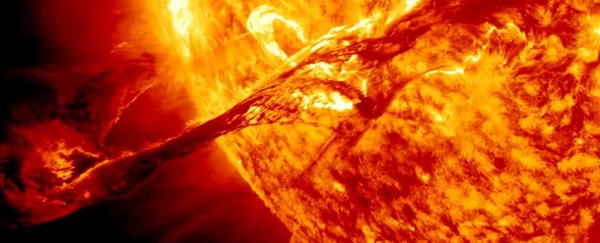Pictures beamed back from a NASA space observatory are helping to solve a mystery that's puzzled scientists since the 1940s: why the outer atmosphere of the Sun, its corona, is hotter than the visible surface.
And we're not talking about a minor temperature discrepancy, either. At the visible surface of the Sun, you can expect a toasty temperature of about 5,500 degrees Celsius (or 9,932 degrees Fahrenheit), but up in the corona, the temperature is around 200 to 500 times hotter.
Now, based on observations from the IRIS (Interface Region Imaging Spectrograph) mission, NASA researchers think the corona is partly heated by 'heat bombs' going off, caused by blasts of energy from magnetic fields criss-crossing and realigning in the corona.
This could also answer the question of whether the corona is being heated uniformly all at once, or in separate pockets that quickly spread out across the upper atmosphere - something scientists have been wondering about since the corona's intense heat was discovered.
IRIS makes figuring this out easier, as it's capable of analysing the solar transition region - the area between the Sun's surface and the corona - and can measure the movement of hot gas in unprecedented detail.
"Because IRIS can resolve the transition region 10 times better than previous instruments, we were able to see hot material rushing up and down magnetic fields in the low corona," explains lead researcher Paola Testa of the Harvard-Smithsonian Centre for Astrophysics.
"This is compatible with models from the University of Oslo, in which magnetic reconnection sets off heat bombs in the corona."
This magnetic reconnection, where heat and energy is released, is also responsible for other phenomena such as solar flares.
Since its launch in 2013, IRIS - which acts kind of like a magnifying glass for studying the edges of the Sun's atmosphere - has been giving us a better look at what's really going on with this kind of solar activity.
Previously, the researchers used IRIS imagery to find evidence of miniature solar flares called nanoflares, where the Sun releases energy by sending hot plasma crashing into its upper atmosphere.
Those nanoflare observations have been backed up by data sent back by another NASA satellite, EUNIS (or Extreme Ultraviolet Normal Incidence Spectrograph).
Now we can add the explosive activity of magnetic fields to the mix too, thanks again to the keen eyes of IRIS.
One way the new research could help us here on Earth is giving us a better idea of when solar storms might strike - events capable of causing serious disruption on our planet, when powerful ejections of solar energy disrupt Earth's magnetic field.
Research into nuclear fusion also relies on a thorough understanding of how the Sun works too. If we want to develop this clean, safe, and almost limitless energy source, then we need to know more about the chemical reactions happening around the Sun.
Solar physicist Bart De Pontieu from the Lockheed Martin Solar & Astrophysics Laboratory says IRIS's technology will continue to provide much better data sets than what scientists previously had to work with.
"The [coronal heating] problem involves a variety of complex physical processes that are difficult to directly measure or capture in theoretical models," he says.
The NASA video below explains coronal heating in more detail:

The findings are published in The Astrophysical Journal.
